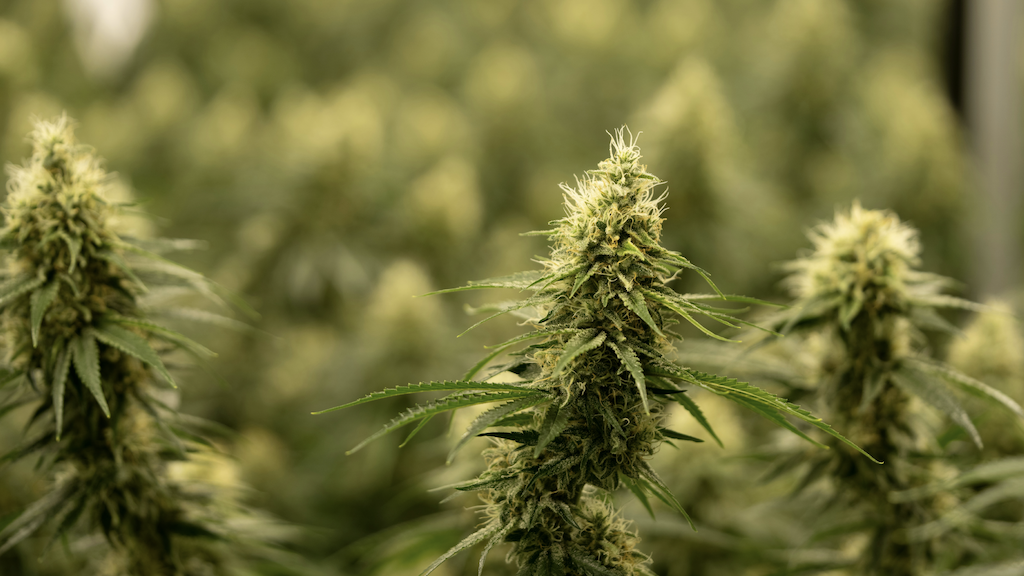Key takeaways:
- Cannabis flower, available in dozens of varieties at Boone Town Provisions, comes in hundreds of cultivars (strains) that may each offer a different experience.
- The cannabis plant, from which flower originates, has four main parts.
- Cannabinoids, terpenes, and flavonoids all shape the cannabis flower’s effects.
- To consume cannabis flower, grinding and rolling, pipes and bowls, one-hitters, pre-rolled joints, and vaporizers are popular options.
- Common types of cannabis flower include premium flower, popcorn buds, pre-ground flower, and shake.
Cannabis flower is the part of a mature cannabis plant that’s dried and cured and that you eventually take home to roll up or vape. It’s also what manufacturers use to make concentrates, edibles, and other cannabis products. In fact, all cannabis products that you’ll find in a cannabis dispensary start from cannabis flower and the compounds found within them.
But there’s a lot more to learn than the basics. This field guide offers everything you need to know about cannabis flower, from its roots to how to shop for it.
What is a strain of cannabis flower?
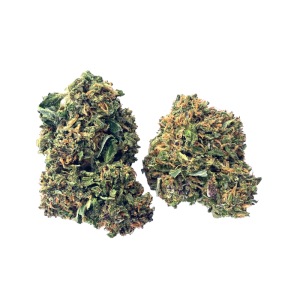
You may have heard some of the amusing names for cannabis flower, like Super Lemon Haze, Gorilla Pie, or Wedding Cake. These refer to different cultivars (strains) of cannabis, which are varieties with unique scents, flavors, appearances, and potential effects. Part of the fun of cannabis is finding which strains are your favorites. After all, all cannabis enthusiasts have their own individual needs and preferences, and there’s bound to be a strain for everyone.
What about indica, sativa, and hybrid cannabis?
When cannabis first evolved naturally, two general species emerged — one in the Western Hemisphere and one in the Eastern Hemisphere. The one in the east was a shorter, thicker variety that was highly potent and caused cerebral effects when consumed. This variety became known as Indica. The Western version, sativa, tended to be tall, stalky, and fibrous; it was more likely to be used for industrial production, like making rope and clothes, than consumption.
For decades, breeders have crossed indica and sativa strains to produce an ever-growing list of hybrid cannabis cultivars. Cross-breeding wasn’t only about selecting certain effects — it was also about creating stronger, healthier plants and increasing how much flower the plant produces. Today, most of the flower you’ll encounter in a cannabis dispensary is from a hybrid strain, though it may be sativa-dominant or indica-dominant in its genetics.
Many people claim you can anticipate how your smoking experience will go based on whether your chosen cultivar is indica or sativa. Indica plants, the conventional wisdom suggests, produce a more calming and relaxing effect, while sativa plants are known for uplifting, energetic vibes. This is not really the case, though. While it may be sometimes true, there are plenty of examples of Sativa-dominant strains that produce a more laid-back experience and Indica-dominant strains that result in a burst of energy. We’ll get into more detail about what really makes cannabis work further below.
Looking to buy cannabis flower but not sure where to start? Check out our guide to common cannabis measurements to get an idea of how much you can buy at a time.
Which part of the plant is the cannabis flower? Understanding plant anatomy
Before we dive into what happens when you consume cannabis flower, let’s take a quick look at the anatomy of a cannabis plant.
Trichomes
Trichomes are the resin glands of the cannabis plant. They’re filled with a resin that contains compounds like cannabinoids, which make cannabis “work.” The trichomes are an important part of protecting the plant from disease and predation, as well as attracting pollinators to help the plant reproduce.
Calyx
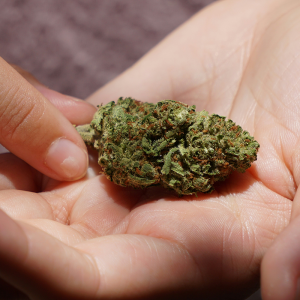
The calyx is the first part of the cannabis flower that forms when a plant reaches maturity. It’s from the calyx that the pistils develop, and it tends to be completely covered in highly resinous trichomes. It protects the plant’s reproductive organs when they’re at their most vulnerable, and it also provides structure and stability for the fledgling bud as it grows.
Pistils
The pistils are an essential reproductive organ of the cannabis flower. When a male cannabis plant releases pollen or a pollinator lands on a female cannabis plant, the pollen sticks to the pistil and fertilizes the flower. The result is a bud that produces more seeds so that when the female plant dies at the end of the season, a new generation is buried underground and awaits the next growing season to emerge.
In cannabis cultivation, female cannabis plants remain unfertilized to encourage the growth of large, potent buds. Some strains of cannabis will be dotted with small orange hairs when you see them in the dispensary — those are the pistils that have shriveled after remaining unfertilized well into maturity.
Bracts
Bracts are small leaves that stick out from a bud as it grows. Their primary job is to protect seeds that are growing within a fertilized bud. Bracts are generally removed after harvest and during trimming, so it’s unlikely you’ll see them in manicured flower that’s for sale at the dispensary. These are different from sugar leaves, which are tiny fan leaves (the large, iconic cannabis leaf) that sometimes stick out of the bud.
What makes cannabis flower work?
Inside the trichomes of cannabis flower, there is a resin that’s packed with compounds responsible for the psychoactive effects (and non-intoxicating effects) you feel when you consume. These include:
Cannabinoids
Cannabinoids are the primary compounds that make cannabis work the way it does. For example, it’s because of Delta-9 Tetrahydrocannabinol (THC) that consuming cannabis might make you feel cerebral, giggly, or hungry.
How THC works is by influencing cannabinoid receptors throughout your brain and body, which in turn influences something called the endogenous cannabinoid system (ECS). The ECS manages a wide range of bodily processes, including appetite, mood, pain perception, inflammation, and much more. It’s thanks to this interaction between cannabinoids and the ECS that cannabis has such wide ranging therapeutic potential.
Other cannabinoids play a big role too. Cannabidiol (CBD) is another household name, but there are roughly 100 others in cannabis flower too, such as Cannabigerol (CBG) or Cannabinol (CBN). The levels in which these cannabinoids are present, and which others are present alongside them, can have a big effect on your experience with a particular strain of cannabis flower.
Terpenes
Terpenes are aromatic compounds found throughout the entire plant kingdom. There are more than 20,000 that have been documented worldwide, but only about 200 or so have been found in cannabis plants. These compounds contribute unique smells and tastes to cannabis flower, and they can also impact your consumption experience and lend additional therapeutic potential to a strain. They aren’t responsible for intoxicating effects (that’s THC’s role) but may modulate them.
For example, the terpene limonene is named for its sweet, citrus scent and flavor. It may also offer uplifting sensations and a burst of energy when present in significant levels, almost like “side effects” to how THC makes you feel. Limonene also provides anti-bacterial, anti-viral, and anti-fungal properties, which is why it’s also a common ingredient in household cleaning products.
Like cannabinoids, the effects of terpenes can change when they’re present in combination with other terpenes. A common bouquet of terpenes you might encounter in cannabis products, for example, is limonene, myrcene, and caryophyllene. Depending on which of these terpenes takes the lead, though, your experience could vary.
Read our cannabis terpenes guide to take a deep dive into the compounds that lend cannabis its aromas and flavors, and how they influence your experience.
Flavonoids
Flavonoids usually take a back seat to cannabinoids and terpenes in conversations about cannabis, but they’re still important compounds in the plant. They lend cannabis flower its color, which ranges from muted tones to vibrant hues of greens, yellows, oranges, blues, and purples. Flavonoids are also thought to offer therapeutic potential of their own, though more research is needed to determine how impactful these traits are for cannabis consumers.
How do you consume cannabis flower?
The most conventional way to consume cannabis flower is by smoking it. The heat from your lighter activates the cannabinoids (the cannabinoids are in their acidic form before they are exposed to heat and turned into “active” cannabinoids). As you inhale, the cannabinoids and terpenes pass through membranes in your lungs and enter your bloodstream. Here are some common methods used to smoke cannabis flower.
Grinding and rolling
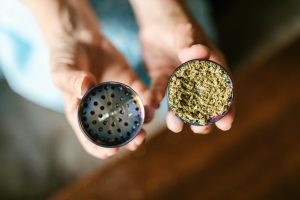
Cannabis flower is ground and rolled into a joint using rolling paper, and the joint is then lit and enjoyed. Joints are handy for passing around with a group of friends during a session. You don’t have to enjoy a whole joint at once, either: you can put it out and save it for later consumption.
Pipes, bongs, bubblers, and bowls
Pipes and bowls are small pipes that can be packed with cannabis flower, which is then lit and puffed on through the mouthpiece. Most bowls feature a carb, a small hole near the bowl used to control airflow when smoking flower.
Bongs and bubblers are large pipes that can be filled with water, providing larger and smoother hits of cannabis for a truly potent session. Many bongs and bubblers double as art, as many glassblowers do their best to show off their skills when making premium pieces.
One-hitters
These tiny pipes hold enough cannabis flower for one good hit. With dugout one-hitters, you can store cannabis flower and smoke it using the same device. There are also chillums, which you smoke like a standard pipe.
Pre-rolled joints
With a pre-roll, you skip the grinding and rolling step and get a ready-to-smoke product. Just light up and enjoy — and save any remaining cannabis for next time.
Vaporizers
The emergence of electronic dry herb vaporizers is great if you find smoking too harsh or if you prefer to avoid the lingering smell that smoking flower produces. Vaporizing cannabis flower is a great option, and all you need is a dry herb-compatible vaporizer to do it.
Dry herb vaporization requires a specialized device that heats the flower instead of taking a flame to it. There are portable and desktop versions. Place ground flower in the vape’s chamber or oven and set the temperature to vaporize it. Following your session, you’ll just need to clean your device out, making for a simple, smooth, discreet way to consume cannabis flower.
Heating types vary in vaporizers. Conduction (direct contact between the flower and the heating element) is most common, but some models instead use convection (indirect contact, with hot air as the vaporizing element). There are even hybrid dry vapes that combine both types of heating.
What types of cannabis flower can you buy in a dispensary?
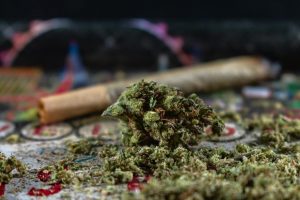
Cannabis flower differs depending on how it’s grown, how it’s harvested, how it’s processed, and even what part of the plant it comes from. Here are some of the types of cannabis flower you’re likely to encounter in a dispensary or hear about when discussing cannabis products.
- Premium flower: These are buds that were cultivated with great care and are meticulously manicured. Premium flower, also called “top shelf” flower, looks, smells, and tastes great. It’s also sold at a higher price point since it’s the best quality flower you can find on the market.
- Popcorn buds: Popcorn buds are cannabis flower that grows around the cola, or main bud, of a flowering cannabis plant. This flower tends to be smaller and a bit less dense, potent, and flavorful, than standard flower, but it contains all the same compounds as bigger buds from the same strain. Usually, popcorn buds are more cost-effective than premium flower, making them a great way to test out a new strain and make sure you like it before spending on premium buds.
- Ground flower: Pre-ground flower is cannabis flower that has been broken down into fine pieces and is ready for use. It is generally a bit more cost-effective than premium cannabis flower or popcorn buds. It’s ideal if you have a hard time grinding flower on your own. Ground flower is also great if you just want something that’s quick and easy to use.
- Shake: Shake is the bits of cannabis flower that fall from the buds and gather at the bottom of containers. Generally, you won’t see shake as a product for sale, but it’s often used to create products like prerolls or cannabis-infused edibles. Shake is generally more cost-effective than other forms of flower. You may also see trim, which is what’s left over after manicuring buds. Trim and shake are technically different products, but the two names are sometimes interchanged.
You may also encounter byproducts of flower such as kief or dry sift. These refer to trichomes and small amounts of plant material that fall from the flower, although they’re not technically cannabis flower themselves. Kief and dry sift can be consumed directly for a more potent experience, though they’re often used to make concentrates like hash and rosin.
Did you know there are limits on how much cannabis you can buy in NJ in a single dispensary visit? Check out our guide to learn more about the rules.
Visit Boone Town for a wide selection of premium flower
At Boone Town Provisions, we pride ourselves on being one of New Jersey’s leading purveyors of top-quality cannabis flower. For a wide ranging selection of premium flower and the most popular strains, swing by our location in Boonton, NJ. Or, if you’re looking for something specific, check out our cannabis flower menu to see what we have in stock before you swing by.
Even if we don’t have your favorite strain in stock, our budtenders will be more than happy to recommend something that will meet your needs. So come say hello and see how Boone Town Provisions is raising the bar in the Garden State’s cannabis scene. Happy trails!

